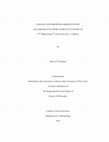Papers by Marvin W Kushnet
Journal of the Oriental Numismatic Society, 2023
Coins of Ascalon in worn condition can be confused with those of Rabbathmoba due to the similarit... more Coins of Ascalon in worn condition can be confused with those of Rabbathmoba due to the similarities of the war deities depicted on the reverse. This paper concentrates on the differences in these figures, as opposed to the similarities, allowing for a secure attribution in many cases. Further discussion is aimed at the identity of Phanebal, war-god unique to Ascalon, and reviews the conclusions of past scholarship regarding the god's gender.

All Things Cypriot: Studies in Honor of Stuart Swiny, 2021
By the end of the Late Bronze Age Cyprus had become a lynchpin of Mediterranean trade, importing ... more By the end of the Late Bronze Age Cyprus had become a lynchpin of Mediterranean trade, importing prestige goods and pottery from the Aegean and Levant while exporting local wares and copper throughout the Mediterranean basin and beyond. With the coming of the Iron Age, two phenomena stand out: the importation of significant amounts of Greek pottery beginning in the late 7th century and the advent of coinage on Cyprus in the late 6th. Both serve as markers of economy, indicators which can be quantified and compared. Imported Greek pottery is found throughout the island, and tabulation of complete pots and sherds forms an extensive database which can be evaluated by statistical analysis. The coinage issued by the city-kingdoms can be assessed in a similar manner by virtue of hoard data, and its types, weights and distribution contribute to our knowledge of economy and exchange. This article will explore the particulars of Greek wares imported by Cyprus, the monetary output of the ten city-kingdoms, and what these materials tell us about connectivity within the island and beyond. It will also examine the effects of war on trade and compare the commercial success of the city-kingdoms based on their access to copper, the circulation of their coinage and their importation of Greek pottery.
American Journal of Roentgenology, 1978

This study focuses on two classes of ancient artifacts pertaining to the Cypriot city-kingdoms, n... more This study focuses on two classes of ancient artifacts pertaining to the Cypriot city-kingdoms, namely silver coinage and imported Greek pottery, and covers the period beginning with the late 6th century, when coinage was first employed on Cyprus, down to 332 B.C., when the island lost its autonomy to Macedonian control. Only finds from archaeological contexts such as published hoards and archaeological excavations are included in the coinage and ceramic catalogs. Material without archaeological provenance or from private and museum collections is in general excluded from the database.
The conclusions derived from this research are based on statistical analysis of the numismatic and ceramic data, and in many instances serve to uphold the work of previous researchers who were compelled to rely on smaller sample sizes, extrapolation and intuition. Graphic analysis clearly demonstrates the movement of Greek pottery to Cyprus prior to, during and after the Persian and Peloponnesian Wars, and prominently profiles what type of pottery was in transit and when. Pottery is classified by date and by site of origin, and the types of vessels are tabulated.
Silver coinage is classified by mint, date, denomination and find site, and output correlated whenever possible with historical context. The movement of Cypriot coinage is also examined, and hoard composition analyzed in an attempt to delineate political and trade alliances. Foreign coins found with Cypriot examples are tabulated and assessed for distance traveled, and denominations of Cypriot coins employed both within the confines of the island and beyond are compiled to determine where and when large or small transactions predominated. A thorough metrological analysis of fraction weight coins gives perspective to the Meniko Hoard. The iconography of the coinage is reviewed, and both correlation analysis and the chi-square method are employed in an attempt to identify uncertain mints and shared trade routes.
As economic indicators, Cypriot coinage and imported Greek pottery demonstrate considerable overlap, but do not necessarily run in tandem. The former is best connected to political or military prowess, whereas the latter is more indicative of distribution centers which are always associated with a major harbor.










Uploads
Papers by Marvin W Kushnet
The conclusions derived from this research are based on statistical analysis of the numismatic and ceramic data, and in many instances serve to uphold the work of previous researchers who were compelled to rely on smaller sample sizes, extrapolation and intuition. Graphic analysis clearly demonstrates the movement of Greek pottery to Cyprus prior to, during and after the Persian and Peloponnesian Wars, and prominently profiles what type of pottery was in transit and when. Pottery is classified by date and by site of origin, and the types of vessels are tabulated.
Silver coinage is classified by mint, date, denomination and find site, and output correlated whenever possible with historical context. The movement of Cypriot coinage is also examined, and hoard composition analyzed in an attempt to delineate political and trade alliances. Foreign coins found with Cypriot examples are tabulated and assessed for distance traveled, and denominations of Cypriot coins employed both within the confines of the island and beyond are compiled to determine where and when large or small transactions predominated. A thorough metrological analysis of fraction weight coins gives perspective to the Meniko Hoard. The iconography of the coinage is reviewed, and both correlation analysis and the chi-square method are employed in an attempt to identify uncertain mints and shared trade routes.
As economic indicators, Cypriot coinage and imported Greek pottery demonstrate considerable overlap, but do not necessarily run in tandem. The former is best connected to political or military prowess, whereas the latter is more indicative of distribution centers which are always associated with a major harbor.
The conclusions derived from this research are based on statistical analysis of the numismatic and ceramic data, and in many instances serve to uphold the work of previous researchers who were compelled to rely on smaller sample sizes, extrapolation and intuition. Graphic analysis clearly demonstrates the movement of Greek pottery to Cyprus prior to, during and after the Persian and Peloponnesian Wars, and prominently profiles what type of pottery was in transit and when. Pottery is classified by date and by site of origin, and the types of vessels are tabulated.
Silver coinage is classified by mint, date, denomination and find site, and output correlated whenever possible with historical context. The movement of Cypriot coinage is also examined, and hoard composition analyzed in an attempt to delineate political and trade alliances. Foreign coins found with Cypriot examples are tabulated and assessed for distance traveled, and denominations of Cypriot coins employed both within the confines of the island and beyond are compiled to determine where and when large or small transactions predominated. A thorough metrological analysis of fraction weight coins gives perspective to the Meniko Hoard. The iconography of the coinage is reviewed, and both correlation analysis and the chi-square method are employed in an attempt to identify uncertain mints and shared trade routes.
As economic indicators, Cypriot coinage and imported Greek pottery demonstrate considerable overlap, but do not necessarily run in tandem. The former is best connected to political or military prowess, whereas the latter is more indicative of distribution centers which are always associated with a major harbor.